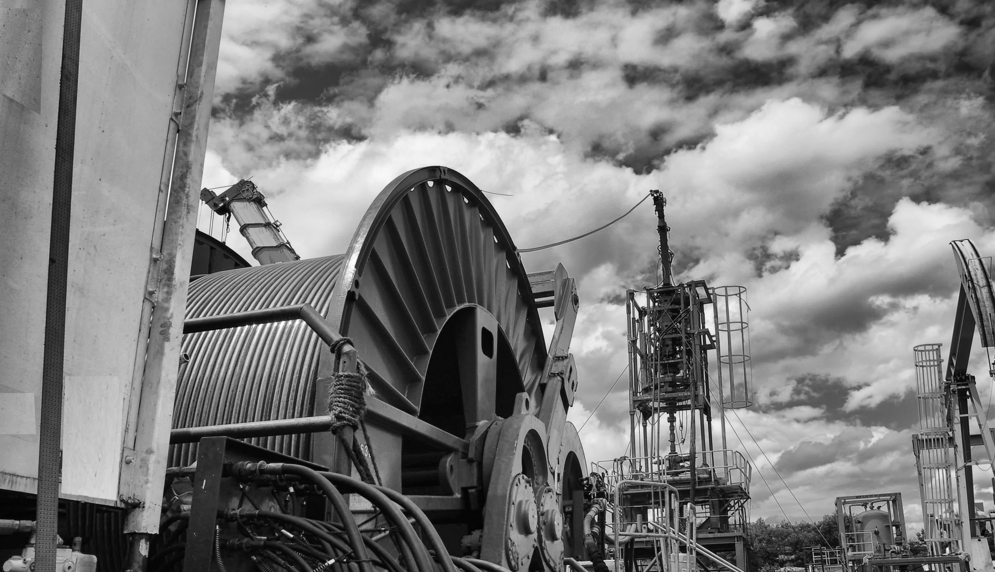Coiled tubing operations (CT) are used to complete or stimulate wells, instead of using conventional well completion methods. The method involves running into a well with a continuous length of coiled tubing that comes in various sizes from 1 ¼” up to 2 ⅞” and then pumping down CT with N2 gas at high pressure.
The use of nitrogen in coiled tubing operations is not a new concept and has been used for years to help reduce the risk of fire and explosion. The presence of oxygen can be detrimental to many aspects of oilfield production, including reducing the life expectancy of equipment, increasing corrosion rates, and creating safety hazards. To combat this, nitrogen is often applied as an inert gas during coiled tubing interventions to displace any oxygen present in the system.
Nitrogen channeled through coiled tubing can be generated by dedicated on-site nitrogen generators. For the following reasons, nitrogen has become the preferred application for oil fields across Western Canada.
Onsite nitrogen generation applications
When liquids and debris accumulate in an active well, they prevent the flow of formation fluids. Gaseous nitrogen is pumped into the reservoirs using onsite generators for safety and efficiency. The nitrogen gas is channeled through coiled tubing to pump out the accumulated liquids. Some of the applications for this process include workovers and drilling operations like shallow drilling, UBD horizontal drilling, and fracturing.
Workovers
Thanks to its low density and high-pressure properties, gaseous nitrogen is the preferred choice in workover and completion operations. It efficiently displaces well fluids to initiate flow and clean wells, making it a great solution in the industry.
Drilling operations
Nitrogen use in drilling operations allows for lighter drilling fluids, reducing the burden on drill bits and enhancing their efficiency.
Nitrogen produced by on-site generators also plays a crucial role in enhancing drilling techniques. For under-balanced drilling, nitrogen can lighten the weight of drilling fluids, boosting production by efficiently reducing hydrostatic pressures that limit performance.
Benefits of onsite nitrogen generation for coiled tubing operations
Quicker startup time
A quicker startup means less downtime, which can be costly for the oil and gas industry. Onsite nitrogen generation eliminates the need to deliver conventional nitrogen tanks, which can experience delays and transportation issues that lead to lost production. Having an onsite nitrogen generator means you have nitrogen supply when and where you need it.
Can reach purity levels of up to 99%
Onsite nitrogen generators provide a consistent flow of nitrogen, which produces a purity level of up to 99%. There is no need to pause operations, and consistency creates a safer work environment.
Cost-effective with very little logistics involved
The traditional way of supplying nitrogen in tanks involves complex logistics, including loading, transportation, delivery, unloading, and application. You can imagine the planning and effort this takes, which becomes even more challenging for temporary remote sites.
Additionally, you’ll need more workers to safely load, transport, and unload nitrogen tanks. You’ll also need to consider nitrogen that is lost during transportation, which can be up to 10% of what the tanks hold – meaning companies are paying for a product that never makes it to the site.
Having an onsite nitrogen generator requires significantly fewer logistics than the traditional method. This is a cost-saving strategy for companies that require a consistent flow of nitrogen.
Better for the environment
The oil and gas industry is constantly under pressure from environmentalists and the public to adopt more environmentally friendly methods. Onsite nitrogen generation is a small yet effective way to operate with an improved environmental impact.
Onsite nitrogen generators do not require cool down or any additional nitrogen delivery as with conventional liquid nitrogen which takes up a significant amount of energy to produce. No constant deliveries and transportation costs mean fewer emissions and a better carbon footprint.
Canadian Nitrogen Services is Western Canada’s Leading Industrial Nitrogen Supplier
Recognized as the top oilfield services provider in Canada for 2023, we are dedicated to delivering unparalleled service and support. Our innovative onsite nitrogen generators not only reduce your operational costs and carbon footprint but also enhance workplace safety and efficiency. Whether you’re in the construction of oil and gas wells or require gaseous nitrogen for various industrial applications, our mobile units deliver reliable, cost-effective, and eco-friendly solutions.
Visit Canadian Nitrogen Services Ltd for an On-site supply of Nitrogen, delivered from state-of-the-art onsite nitrogen generators! Contact us for more information.
Frequently asked questions
What are the safety benefits of using nitrogen in coiled tubing operations?
Nitrogen reduces the risk of fire and explosions by displacing oxygen, which is crucial in volatile environments like oil fields.
How does onsite nitrogen generation improve operational efficiency?
Onsite generation minimizes downtime and logistical issues associated with transporting nitrogen, ensuring a continuous and reliable supply directly at the site.
Can nitrogen use in coiled tubing operations lead to better environmental outcomes?
Yes, using nitrogen helps reduce emissions associated with transportation and decreases the overall energy consumption of operations.
What are the cost benefits of using an onsite nitrogen generator for coiled tubing operations?
Onsite nitrogen generation reduces the need for transportation and handling of nitrogen in tanks, which not only cuts down costs but also reduces the loss of nitrogen during transport, making it a more cost-effective solution.
In what ways is nitrogen used during different stages of well operations?
Nitrogen is versatile and used in various stages to enhance efficiency and safety, including well stimulation, underbalanced drilling, and pipeline purging.


